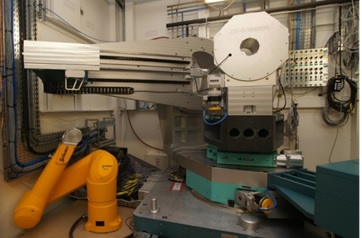IRT Nanoelec’s Advanced Characterization Platform – Grenoble (PAC-G) has acquired new equipment for industrial R&D; the instrument was recently installed on the ESRF synchrotron BM05 beamline. Industrial R&D partners using the instrument will also receive comprehensive services including needs analysis, measurement, data analysis, and a full report. To ensure the level of responsiveness businesses need, several days each month will be set aside for industrial R&D users.
The new equipment was financed by IRT Nanoelec and ESRF (50% each) and includes a five-circle goniometer, a robot that automatically positions 300 mm and 200 mm wafers on the diffractometer, a mirror to focus the beam at less than 30 microns, an optical microscope to locate the areas (measuring just several microns) to be observed, and two two-dimensional detectors effective at high levels of X-ray synchrotron radiation and offering spatial resolution of 60 microns. The large size of one of the two detectors (25 cm x 2.5 cm) makes it possible to rapidly map reciprocal space.
The BM05 beamline offers optimized X-ray beams of between 6 keV and 60 keV. When used in conjunction with this new instrument, the beamline can take diffraction measurements in and out of field, reflection and transmission measurements, and reflectivity measurements in both reflection and transmission modes. The adjustable beam size also enables sampling from tens of microns to several millimeters, offering resolutions compatible with mapping a 140 mm x 140 mm area of a wafer with no human intervention required.
Starting at the end of June 2016, the instrument will be available for reflectivity measurements in reflection mode and simple diffraction measurements (determining phase, grain size). Later, new techniques will be added (CDSAXS, in-situ/in-operando, anomalous diffraction and reflectivity, pair distribution function, identifying constraints in thin films, etc.). The equipment can also currently be used for X-ray diffraction imaging (white or monochromatic beam topography) to map surface dislocations on monocrystalline substrates or to acquire 3D images of objects with micrometric resolutions using parallel-beam micro tomography.

Diffractometer and robot installed on BM05 at ESRF.
| Laboratory X-ray source | BM05 | |
| Beam type | Monochromatic | Monochromatic/pink/white |
| Energy | 8 keV (Cu), 17 keV (Mo), 22 keV (Ag) | Adjustable from 6 keV to 60 keV; E/E = 10-4 |
| Flow | 107 photons/s/mm2 | 1010 photons/s/mm2 at 25 keV and 200 mA |
| Beam size | mm² | From 20 microns (wide) to 40 x 8 mm2 |
Performance of a laboratory X-ray source vs. the ESRF BM05 beamline




